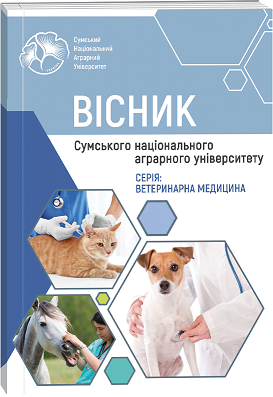COMPARATIVE ANALYSIS OF THE REHABILITATION POTENTIAL OF CATS WITH DIFFERENT TYPES OF FEEDING
Abstract
The main purpose of this work was to compare the rehabilitation potential of homeless cats with different types of diet in the conditions of a two-month stay in a shelter. 29 clinically healthy cats were selected and divided into three groups. During the research, live weight, 12 hematological and 11 biochemical indicators were determined. The selection of samples and the study of indicators took place on the first day of the cats' stay in the shelter and after 30 and 60 days. During the first measurement, it was found that the indicators in the groups for different categories of feed statistically differ from each other, although all the animals were clinically healthy. There was a statistically significant difference in live weight between the first and other groups and a significant increase in live weight after 60 days in all groups. The dependence of the level of hematological indicators, as well as biochemical tests characterizing the metabolic profile of animals, is statistically substantiated. For 60 days, a decrease in the number of leukocytes, segmented neutrophils, eosinophils, total protein and globulins, total calcium and inorganic phosphorus, activity of ALT, alkaline phosphatase was observed against the background of an increase in the level of albumins, erythrocytes and hematocrit. There was a variable statistical difference between the groups on many parameters throughout the study, except for alkaline phosphatase, creatinine, basophils, platelets, and band neutrophils, which did not differ between groups statistically. The reasons for the differences in laboratory indicators in the blood of cats were the age of the animals and the type of feed, but these changes did not go beyond the reference values of the norm. The use of any of these foods for 60 days contributed to the adaptation of the animals' bodies to the conditions of being in the shelter, and our study helped to develop sensitive, reliable and objective criteria for assessing the welfare and well-being of animals to improve the existence of cats in shelters. Currently, there is no consensus on the criteria for assessing the well-being and well-being of cats in shelters due to the existing differences in housing conditions and in general due to the multifactorial nature of stress factors, and therefore, the results of the study by the authors of this publication have improved sensitive and objective assessment criteria for improving the existence of cats in shelters.
References
2. Carlisle, G. K., Johnson, R. A., Koch, C. S., Lyons, L. A., Wang, Z., Bibbo, J., & Cheak-Zamora, N. (2021). Exploratory Study of Fecal Cortisol, Weight, and Behavior as Measures of Stress and Welfare in Shelter Cats During Assimilation Into Families of Children With Autism Spectrum Disorder. Frontiers in veterinary science, 8, 643803. https://doi.org/10.3389/fvets.2021.643803
3. Contreras, E. T., Vanderstichel, R., Hovenga, C., & Lappin, M. R. (2021). Evaluation of hair and nail cortisol concentrations and associations with behavioral, physical, and environmental indicators of chronic stress in cats. Journal of veterinary internal medicine, 35(6), 2662–2672. https://doi.org/10.1111/jvim.16283
4. Dalais, R. J., Calver, M. C., & Farnworth, M. J. (2023). Piloting an International Comparison of Readily Accessible Online English Language Advice Surrounding Responsible Cat Ownership. Animals : an open access journal from MDPI, 13(15), 2434. https://doi.org/10.3390/ani13152434
5. Dezubiria, P., Amirian, E. S., Spera, K., Crawford, P. C., & Levy, J. K. (2023). Animal shelter management of feline leukemia virus and feline immunodeficiency virus infections in cats. Frontiers in veterinary science, 9, 1003388. https://doi.org/10.3389/fvets.2022.1003388
6. Donato, G., Pennisi, M. G., Persichetti, M. F., Archer, J., & Masucci, M. (2023). A Retrospective Comparative Evaluation of Selected Blood Cell Ratios, Acute Phase Proteins, and Leukocyte Changes Suggestive of Inflammation in Cats. Animals : an open access journal from MDPI, 13(16), 2579. https://doi.org/10.3390/ani13162579
7. Dubin, R., Ananchenko, V., Akimova, A., & Ivleva, O. (2024). Kompleksna patolohiia pechinky, nyrok, pidshlunkovoi zalozy u domashnikh kotiv. Ahrarnyi visnyk Prychornomoria, (112), 22-25. https://doi.org/10.37000/abbsl.2024.112.03
8. Ellis J. J. (2022). Beyond "Doing Better": Ordinal Rating Scales to Monitor Behavioural Indicators of Well-Being in Cats. Animals : an open access journal from MDPI, 12(21), 2897. https://doi.org/10.3390/ani12212897
9. Fukimoto, N., Melo, D., Palme, R., Zanella, A.J., & Mendonça-Furtado, O. (2020). Are cats less stressed in homes than in shelters? A study of personality and faecal cortisol metabolites. Applied Animal Behaviour Science, 224, 104919. https://doi.org/10.1016/j.applanim.2019.104919
10. Guenther, K. M., & Hassen, K. (2024). Coming to Terms with the Legacies of the Pound Model in Animal Sheltering in the United States. Animals: an open access journal from MDPI, 14(9), 1254. https://doi.org/10.3390/ani14091254
11. Horecka, K., & Neal, S. (2022). Critical Problems for Research in Animal Sheltering, a Conceptual Analysis. Frontiers in veterinary science, 9, 804154. https://doi.org/10.3389/fvets.2022.804154
12. Hurley, K. F., & Levy, J. K. (2022). Rethinking the Animal Shelter's Role in Free-Roaming Cat Management. Frontiers in veterinary science, 9, 847081. https://doi.org/10.3389/fvets.2022.847081
13. Hurley K. F. (2022). The Evolving Role of Triage and Appointment-Based Admission to Improve Service, Care and Outcomes in Animal Shelters. Frontiers in veterinary science, 9, 809340. https://doi.org/10.3389/fvets.2022.809340
14. Jafarian, S., Akpek, E., Reinhard, C. L., & Watson, B. (2022). A Qualitative Analysis of Clinical Year Veterinary Student Journal Entries for a Shelter Medicine Rotation. Frontiers in veterinary science, 9, 858419. https://doi.org/10.3389/fvets.2022.858419
15. Jaroš F. (2021). The Cohabitation of Humans and Urban Cats in the Anthropocene: The Clash of Welfare Concepts. Animals : an open access journal from MDPI, 11(3), 705. https://doi.org/10.3390/ani11030705
16. Kennedy, B. P. A., Cumming, B., & Brown, W. Y. (2020). Global Strategies for Population Management of Domestic Cats (Felis catus): A Systematic Review to Inform Best Practice Management for Remote Indigenous Communities in Australia. Animals : an open access journal from MDPI, 10(4), 663. https://doi.org/10.3390/ani10040663
17. Kilgour, R. J., & Flockhart, D. T. T. (2022). Direct and Indirect Factors Influencing Cat Outcomes at an Animal Shelter. Frontiers in veterinary science, 9, 766312. https://doi.org/10.3389/fvets.2022.766312
18. Lepczyk, C.A., Calver, M.C. Cat got your tongue? The misnomer of ‘community cats’ and its relevance to conservation. Biol Invasions 24, 2313–2321 (2022). https://doi.org/10.1007/s10530-022-02788-5
19. Levchenko, V. I., Holovakha, V. I., & Kondrakhin, I. P. (2010). Metody laboratornoi klinichnoi diahnostyky khvorob tvaryn. [Methods of laboratory clinical diagnostics of animal diseases]. Kyiv:Ahrarna osvita [in Ukrainian].
20. Lockhart, H. L., Levy, J. K., Amirian, E. S., Hamman, N. T., & Frenden, M. K. (2020). Outcome of cats referred to a specialized adoption program for feline leukemia virus-positive cats. Journal of feline medicine and surgery, 22(12), 1160–1167. https://doi.org/10.1177/1098612X20913359
21. Luzardo, O. P., Zaldívar-Laguía, J. E., Zumbado, M., & Travieso-Aja, M. D. M. (2023). The Role of Veterinarians in Managing Community Cats: A Contextualized, Comprehensive Approach for Biodiversity, Public Health, and Animal Welfare. Animals : an open access journal from MDPI, 13(10), 1586. https://doi.org/10.3390/ani13101586
22. Makovska, I., Nedosekov, V., Polupan, I., & Latmanizova, T. (2018). Analiz trendu poshyrennnia skazu kotiv v Ukraini. NV LNU veterynarnoi medytsyny ta biotekhnolohii. Seriia: Veterynarni nauky, 20(92), 18-23 (in Ukrainian). https://doi.org/10.32718/nvlvet9204
23. Mundschau, V., & Suchak, M. (2023). When and Why Cats Are Returned to Shelters. Animals : an open access journal from MDPI, 13(2), 243. https://doi.org/10.3390/ani13020243
24. Rehme, T., Hartmann, K., Truyen, U., Zablotski, Y., & Bergmann, M. (2022). Feline Panleukopenia Outbreaks and Risk Factors in Cats in Animal Shelters. Viruses, 14(6), 1248. https://doi.org/10.3390/v14061248
25. Righi, C., Menchetti, L., Orlandi, R., Moscati, L., Mancini, S., & Diverio, S. (2019). Welfare Assessment in Shelter Dogs by Using Physiological and Immunological Parameters. Animals : an open access journal from MDPI, 9(6), 340. https://doi.org/10.3390/ani9060340
26. Rodriguez, L., & Berliner, E. A. (2023). Outbreak management of multidrug-resistant Bordetella bronchiseptica in 16 shelter-housed cats. Journal of feline medicine and surgery, 25(2), 1098612X231153051. https://doi.org/10.1177/1098612X231153051
27. Stavisky, J., Watson, B., Dean, R., Merritt, B. L., van der Leij, R. W. J. R., & Serlin, R. (2020). Development of International Learning Outcomes for Shelter Medicine in Veterinary Education: A Delphi Approach. Journal of veterinary medical education, e20200027. Advance online publication. https://doi.org/10.3138/jvme-2020-0027
28. Stockman, J., Villaverde, C., & Corbee, R. J. (2021). Calcium, Phosphorus, and Vitamin D in Dogs and Cats: Beyond the Bones. The Veterinary clinics of North America. Small animal practice, 51(3), 623–634. https://doi.org/10.1016/j.cvsm.2021.01.003
29. Tymoshenko, O.P., & Sydelov, V.V. (2024). Laboratorni kryterii stanu zdorovia sviiskykh kotiv v umovakh utrymannia u prytulkakh dlia tvaryn. [Laboratory criterias for the health status of domestic cats in animal shelters]. Veterinary Science, Technologies of Animal Husbandry and Nature Management, (9), 224-236 [in Ukrainian]. https://doi.org/10.5281/zenodo.12784084
30. van der Leij, W. J. R., Vernooij, J. C. M., Vinke, C. M., Corbee, R. J., & Hesselink, J. W. (2023). Quantification of a shelter cat population: Trends in intake, length of stay and outcome data of cats in seven Dutch shelters between 2006 and 2021. PLOS one, 18(5), e0285938. https://doi.org/10.1371/journal.pone.0285938
31. Vojtkovská, V., Voslářová, E., & Večerek, V. (2020). Methods of Assessment of the Welfare of Shelter Cats: A Review. Animals : an open access journal from MDPI, 10(9), 1527. https://doi.org/10.3390/ani10091527
32. Vojtkovská, V., Voslářová, E., & Večerek, V. (2021). Changes in Health Indicators of Welfare in Group-Housed Shelter Cats. Frontiers in veterinary science, 8, 701346. https://doi.org/10.3389/fvets.2021.701346
33. Vojtkovská, V., Kaluža, M., Voslářová, E., Večerek, V., & Tomečková, L. (2022). The morbidity and the spectrum of applied drugs in shelter cats in the Czech Republic. Frontiers in veterinary science, 9, 1025197. https://doi.org/10.3389/fvets.2022.1025197
34. Vojtkovská, V., Voslářová, E., & Večerek, V. (2024). Causes of shelter cats mortality in the Czech Republic. Veterinary and animal science, 25, 100379. https://doi.org/10.1016/j.vas.2024.100379
35. Wagner, D., Hurley, K., & Stavisky, J. (2018). Shelter housing for cats: Principles of design for health, welfare and rehoming. Journal of feline medicine and surgery, 20(7), 635–642. https://doi.org/10.1177/1098612X18781388
36. Wandesforde-Smith, G., Levy, J. K., Lynn, W., Rand, J., Riley, S., Schaffner, J. E., & Wolf, P. J. (2021). Coping With Human-Cat Interactions Beyond the Limits of Domesticity: Moral Pluralism in the Management of Cats and Wildlife. Frontiers in veterinary science, 8, 682582. https://doi.org/10.3389/fvets.2021.682582
37. Winzelberg Olson, S., & Hohenhaus, A. E. (2019). Feline non-regenerative anemia: Diagnostic and treatment recommendations. Journal of feline medicine and surgery, 21(7), 615–631. https://doi.org/10.1177/1098612X19856178
38. Wojtaś, J., Czyżowski, P., Kaszycka, K., Kaliszyk, K., & Karpiński, M. (2024). The Impact of Environmental Enrichment on the Cortisol Level of Shelter Cats. Animals : an open access journal from MDPI, 14(9), 1392. https://doi.org/10.3390/ani14091392
39. Wolf, P. J., & Hamilton, F. (2020). Managing free-roaming cats in U.S. cities: An object lesson in public policy and citizen action. Journal of Urban Affairs, 44(2), 221–242. https://doi.org/10.1080/07352166.2020.1742577

 ISSN
ISSN  ISSN
ISSN 



